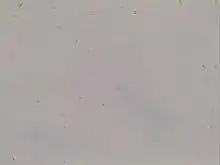Chlorella sorokiniana
Chlorella sorokiniana is a species of freshwater green microalga in the Division Chlorophyta. It has a characteristic emerald-green color and pleasant grass odor. Its cells divide rapidly to produce four new cells every 17 to 24 hours. The alga was found by a Dutch microbiologist Martinus W. Beijerinck in 1890. In 1951, the Rockefeller Foundation in collaboration with the Japanese Government and Hiroshi Tamiya developed the technology to grow, harvest and process Chlorella sorokiniana on a large, economically-feasible scale. This microalga has also been used extensively as a model system to study enzymes involved in higher plant metabolism.[1]
| Chlorella sorokiniana | |
|---|---|
 | |
| C. sorokiniana cells 400× magnification | |
| Scientific classification | |
| Phylum: | Chlorophyta |
| Class: | Trebouxiophyceae |
| Order: | Chlorellales |
| Family: | Chlorellaceae |
| Genus: | Chlorella |
| Species: | C. sorokiniana |
| Binomial name | |
| Chlorella sorokiniana Shihira & R.W.Krauss | |
Also, Chlorella sorokiniana is used to research a way to improve biofuel efficiency.[2]
References
This article is issued from Wikipedia. The text is licensed under Creative Commons - Attribution - Sharealike. Additional terms may apply for the media files.